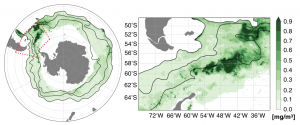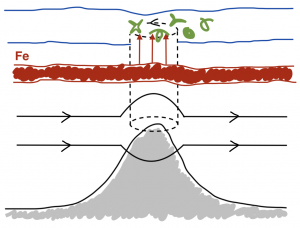Source: Prend, C. J., S. T. Gille, L. D. Talley, B. G. Mitchell, I. Rosso, and M. R. Mazloff (2019), Physical drivers of phytoplankton bloom initiation in the Southern Ocean’s Scotia Sea. Journal of Geophysical Research: Oceans, 124, doi:10.1029/2019JC015162.
The ocean regulates the global climate system by taking up heat and carbon dioxide (CO2) from the atmosphere. The Southern Ocean, which surrounds Antarctica, accounts for nearly 30% of the global oceanic uptake of anthropogenic carbon. One mechanism by which CO2 is transferred from the atmosphere to the ocean is through photosynthesizing algae called phytoplankton. When these organisms die and sink to the seafloor, the carbon they absorbed gets stored in the deep ocean. Therefore, understanding the processes that determine the distribution of phytoplankton in the Southern Ocean is important to accurately model the global carbon cycle and marine ecosystems.
Just like flowers and other land plants, phytoplankton go through periods of rapid growth in spring called blooms. Blooms occur as a result of higher light levels and enhanced stratification, which increases the available nutrient concentrations in the upper ocean where phytoplankton grow. The limiting nutrient preventing phytoplankton growth in the Southern Ocean is iron, so the pathways that deliver iron to the upper ocean are key in controlling bloom location.
A recent study in the Journal of Geophysical Research examines the physical processes that support the southern Scotia Sea phytoplankton bloom, which is the earliest and largest phytoplankton bloom in the Antarctic Circumpolar Current (ACC). This can be seen from a map of satellite chlorophyll, a proxy for phytoplankton biomass, which shows high values in the Scotia Sea (outlined in red) while the rest of the Southern Ocean remains low (Figure 1).

Making observations in the Antarctic is difficult due to rough seas and harsh weather conditions, so this study makes use of data collected by autonomous robotic floats that drift with the ocean currents and take measurements every 10 days. These are the first direct measurements of the bloom in this region, since it’s difficult to access by ship at the time of bloom initiation. The data show that biological productivity is closely linked to seafloor topography since the highest chlorophyll values were measured when floats were trapped in a recirculating eddy that formed over a seamount.
Why would phytoplankton growth be related to topography? The iron that supports the bloom is transported from the Antarctic coast to the Scotia Sea at around 200 meters depth. When currents flow over the seamount, enhanced mixing delivers iron up to the sunlit upper ocean where phytoplankton grow. This process is summarized in Figure 2.

The distribution of biological productivity in the Southern Ocean is very patchy. But several other phytoplankton blooms in the ACC, also located close to topographic features, suggest that this process may be important in other locations as well. Trying to understand what controls bloom location is important given the key role of phytoplankton in marine food webs and the global carbon cycle.
I’m a physical oceanography PhD student at Scripps Institution of Oceanography in La Jolla, California. I use a combination of numerical models, observations, and remote sensing to investigate the role of the ocean in climate. I’m particularly interested in Southern Ocean dynamics, including air-sea-ice interactions and physical controls on biogeochemistry.


